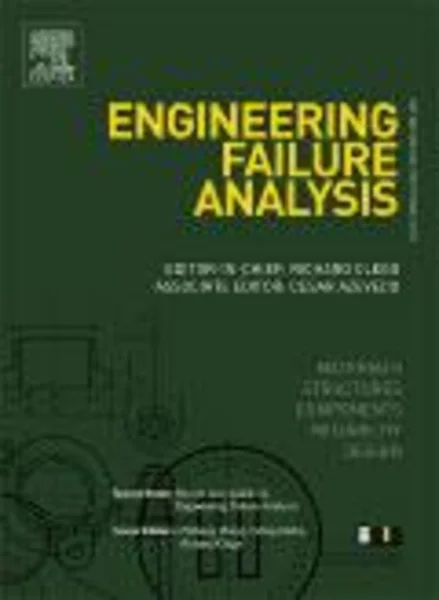-
failure analysis of a hard-drawn water tube leakage caused by the synergistic actions of pitting corrosion and stress–corrosion cracking
جزئیات بیشتر مقاله- تاریخ ارائه: 1390/01/01
- تاریخ انتشار در تی پی بین: 1390/01/01
- تعداد بازدید: 497
- تعداد پرسش و پاسخ ها: 0
- شماره تماس دبیرخانه رویداد: -
unalloyed high purity copper, deoxidized with phosphorus is widely used in tubing and fittings for sanitary installations due to its ease of use and corrosion resistance properties. certain factors related to installation operating conditions on the one hand, and improper design/installation features on the other hand, often lead to unexpected failures. the case examines a cu-tube that failed in a pump station after 2–3 years in-service. the investigation findings suggest strongly that the failure was the result of a complex mechanism involving corrosion–erosion process, facilitated by stress–corrosion cracking mechanism. stress–corrosion cracking referred as a delayed failure mechanism resulted from the synergistic effect of corrosive environment, susceptible material and externally applied or residual – due to the manufacturing process-stress. in case of hard-drawn tubes, the development of tensile (circumferential or hoop) stress field at the outer surface area after cold drawing, enhances the propensity for stress–corrosion cracking (scc), especially under the presence of corrosive environment.
مقالات جدیدترین رویدادها
-
استفاده از تحلیل اهمیت-عملکرد در ارائه الگوی مدیریت خلاقیت سازمانی و ارائه راهکار جهت بهبود
-
بررسی تاثیر ارزش وجوه نقد مازاد بر ساختار سرمایه شرکت های پذیرفته شده در بورس اوراق بهادار تهران
-
بررسی تأثیر سطح افشای ریسک بر قرارداد بدهی شرکت های پذیرفته شده در بورس اوراق بهادار تهران
-
بررسی تأثیر رتبه بندی اعتباری مبتنی بر مدل امتیاز بازار نوظهور بر نقد شوندگی سهام با تأکید بر خصوصی سازی شرکت ها
-
تأثیر آمیخته بازاریابی پوشاک ایرانی بر تصویر ذهنی مشتری پوشاک ایرانی (هاکوپیان)
-
بررسی فرآیندهای ژئوشیمیایی حاکم بر کیفیت آب زیرزمینی آبخوان عقیلی، استان خوزستان
-
مطالعه و بررسی آزمایش های مربوط به بتن خود متراکم (scc) در فاز خمیری و تفسیر نتایج بدست آمده
-
مقایسه عددی رفتار ستون های cfst و srcfst تحت بارهای متناوب
-
بررسی تاثیر تقلب در اعتبار اسنادی صادره از بانک ها در حقوق ایران
-
تحلیل پایداری چاه توسط معیارهای شکست مور – کلمب و موگی – کلمب در یکی از مخازن جنوب غرب ایران
مقالات جدیدترین ژورنال ها
-
مدیریت و بررسی افسردگی دانش آموزان دختر مقطع متوسطه دوم در دروان کرونا در شهرستان دزفول
-
مدیریت و بررسی خرد سیاسی در اندیشه ی فردوسی در ادب ایران
-
واکاوی و مدیریت توصیفی قلمدان(جاکلیدی)ضریح در موزه آستان قدس رضوی
-
بررسی تاثیر خلاقیت، دانش و انگیزه کارکنان بر پیشنهادات نوآورانه کارکنان ( مورد مطالعه: هتل های 3 و 4 ستاره استان کرمان)
-
بررسی تاثیر کیفیت سیستم های اطلاعاتی بر تصمیم گیری موفق در شرکتهای تولیدی استان اصفهان (مورد مطالعه: مدیران شرکتهای تولیدی استان اصفهان)
-
بررسی اثر بخشی فناوری اطلاعات بر عملکرد مدیران مدارس شهرستان لردگان
-
مطالعه ای بر تاثیر رسانه های اجتماعی در تشویق و ترغیب مردم برای مشارکت در انتخابات ریاست جمهوری 1400
-
تراداستان و سفر تراداستانی: گونه ها و کاربست ها
-
spatial analysis of quality of life in economic dimension of villages of lahijan town
-
a comparative study of the carbonyl positioning mechanism in the mn (co) 5 ch2f and mn (co) 5chf2 complex through quantum chemistry




سوال خود را در مورد این مقاله مطرح نمایید :